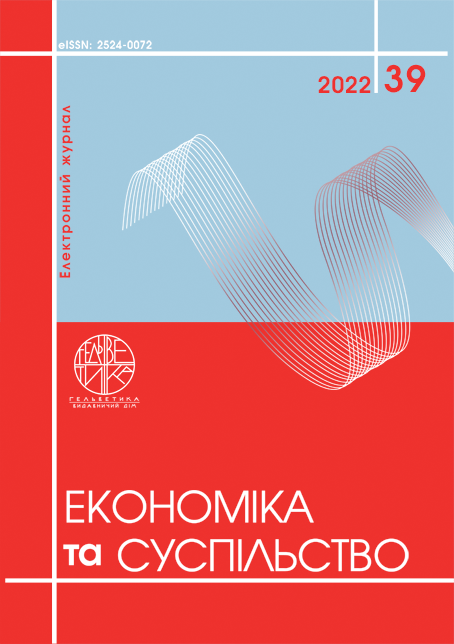ESSENCE AND COMPONENTS COMMUNITY RESILIENCE IN THE CONTEXT OF COVID-19
Abstract
The aim of the article is to systematize scientific approaches to defining the essence of resilience in relation to the community, identifying its specific features, as well as the main components of the formation of resilience of the community in the context of COVID-19. The study was conducted on the basis of analysis and systematization of approaches presented in Ukrainian and foreign scientific papers. According to the results of the study, it is determined that the interpretation of the term “community resilience” is carried out from the standpoint of the following 4 approaches: resilience as an attribute of the community; resilience as a process of changing the state of the community; resilience as adaptation and preservation of a stable state of the community; resilience as community strengthening and development in response to a risk factor. Since the term “resilience” can be used to describe certain objects or entities (individuals, community, society in general, political or other institutions), the article identifies specific features of community resilience, namely: 1) risk factors may have as external origin, and be determined by certain internal impulses; 2) the community is characterized by certain geographical boundaries, social and political system; 3) the level of resilience of the community affects the resilience of its members, the level and quality of their lives. The article considers the theoretical model of community resilience, which is implemented in 4 stages: realization of the risk factor; activation of protective factors and vulnerabilities; interaction between protective factors and vulnerabilities; and the result is resilience or maladaptation of the community. Based on the generalization of existing approaches, the main components of community resilience have been identified, which include social capital, economic development, human capital, physical resources, and geographical location. The role of these components is characterized in terms of the formation of resistance in a COVID-19 pandemic. The results of the study are the basis for further assessment of the level of resilience of communities in terms of selected components and the development of ways to improve the resilience.
References
Корольчук О.Л. Характеристики резильєнтності системи охорони здоров’я: міжнародний досвід для України. Публічне управління і адміністрування в Україні. 2021. № 23. С. 35–41. DOI: https://doi.org/10.32843/pma2663-5240-2021.23.6
Лазос Г. П. Теоретико-методологічна модель резильєнтності як основа побудови психотехнології її розвитку. Організаційна психологія. Економічна психологія. 2019. № 2-3 (17). С. 77–89. DOI: https://doi.org/10.31108/2.2019.3.17.9
Definitions of Community Resilience: An Analysis. Community & Regional Resilience Institute. 2013. 14 p. URL: https://s31207.pcdn.co/wp-content/uploads/2019/08/Definitions-of-community-resilience.pdf
Fan Y., Lyu X. Exploring Two Decades of Research in Community Resilience: A Content Analysis Across the International Literature. Psychology Research and Behavior Management. 2021. № 14. P. 1643–1654. DOI: https://doi.org/10.2147/PRBM.S329829
Faulkner L., Brown K., Quinn T. Analyzing community resilience as an emergent property of dynamic social-ecological systems. Ecology and Society. 2018. № 23(1). P. 24. DOI: https://doi.org/10.5751/ES-09784-230124
Fenxia Z. The community resilience measurement throughout the COVID-19 pandemic and beyond – an empirical study based on data from Shanghai, Wuhan and Chengdu. International journal of disaster risk reduction: IJDRR. 2022. № 67, 102664. DOI: https://doi.org/10.1016/j.ijdrr.2021.102664
Kulig J. C. Community resiliency: The potential for community health nursing theory development. Public Health Nursing. 2000. № 17(5). P. 374–385. DOI: https://doi.org/10.1046/j.1525-1446.2000.00374.x
Meng B., Li N., Fang D. Attributes, challenges and future directions of community resilience. Frontiers of Engineering Management. 2018. № 5(3). P. 307‒323. DOI: https://doi.org/10.15302/J-FEM-2018030
Menzies J., Raskovic M. Taming COVID-19 through Social Resilience: A Meta-Capability Policy Framework from Australia and New Zealand. AIB Insights. 2020. № 20(3). DOI: https://doi.org/10.46697/001c.18165
Patel S. S., Rogers M. B., Amlôt R., Rubin G. J. What Do We Mean by 'Community Resilience'? A Systematic Literature Review of How It Is Defined in the Literature. PLoS currents. 2017. № 9. DOI: https://doi.org/10.1371/currents.dis.db775aff25efc5ac4f0660ad9c9f7db2
Valinejad J., Guo Zh., Cho J.-H., Chen I.-R. Measuring Community Resilience During the COVID-19 based on Community Wellbeing and Resource Distribution. medRxiv. 2022. 2022.05.23.22275454. DOI: https://doi.org/10.1101/2022.05.23.22275454
Korolchuk, O. L. (2021). Kharakterystyky rezylientnosti systemy okhorony zdorovia: mizhnarodnyi dosvid dlia Ukrainy [Resilience characteristics of the health care system: international experience for Ukraine]. Publichne upravlinnia i administruvannia v Ukraini – Public administration in Ukraine. 23, 35–41. DOI: https://doi.org/10.32843/pma2663-5240-2021.23.6 (in Ukrainian)
Lazos, H. P. (2019). Teoretyko-metodolohichna model rezylientnosti yak osnova pobudovy psykhotekhnolohii yii rozvytku [Theoretical and methodological model of resilience as a basis for constructing psychotechnology of its development]. Orhanizatsiina psykholohiia. Ekonomichna psykholohiia – Organizational psychology. Economic psychology. 2-3(17), 77–89. DOI: https://doi.org/10.31108/2.2019.3.17.9 (in Ukrainian)
Community & Regional Resilience Institute (2013). Definitions of Community Resilience: An Analysis. 14 p. Available at: https://s31207.pcdn.co/wp-content/uploads/2019/08/Definitions-of-community-resilience.pdf
Fan, Y., & Lyu, X. (2021). Exploring Two Decades of Research in Community Resilience: A Content Analysis Across the International Literature. Psychology Research and Behavior Management. 14, 1643–1654. DOI: https://doi.org/10.2147/PRBM.S329829
Faulkner, L., Brown, K., & Quinn, T. (2018). Analyzing community resilience as an emergent property of dynamic social-ecological systems. Ecology and Society. 23(1), 24. DOI: https://doi.org/10.5751/ES-09784-230124
Fenxia, Z. (2022). The community resilience measurement throughout the COVID-19 pandemic and beyond – an empirical study based on data from Shanghai, Wuhan and Chengdu. International journal of disaster risk reduction: IJDRR. 67, 102664. DOI: https://doi.org/10.1016/j.ijdrr.2021.102664
Kulig, J. C. (2000). Community resiliency: The potential for community health nursing theory development. Public Health Nursing. 17(5), 374–385. DOI: https://doi.org/10.1046/j.1525-1446.2000.00374.x
Meng, B., Li, N., & Fang, D. (2018). Attributes, challenges and future directions of community resilience. Frontiers of Engineering Management. 5(3), 307‒323. DOI: https://doi.org/10.15302/J-FEM-2018030
Menzies, J., & Raskovic, M. (2020). Taming COVID-19 through Social Resilience: A Meta-Capability Policy Framework from Australia and New Zealand. AIB Insights. 20(3). DOI: https://doi.org/10.46697/001c.18165.
Patel, S. S., Rogers, M. B., Amlôt, R., & Rubin, G. J. (2017). What Do We Mean by 'Community Resilience'? A Systematic Literature Review of How It Is Defined in the Literature. PLoS currents. 9. DOI: https://doi.org/10.1371/currents.dis.db775aff25efc5ac4f0660ad9c9f7db2
Valinejad, J., Guo, Zh., Cho, J.-H., & Chen, I.-R. (2022). Measuring Community Resilience During the COVID-19 based on Community Wellbeing and Resource Distribution. medRxiv. 2022.05.23.22275454. DOI: https://doi.org/10.1101/2022.05.23.22275454


